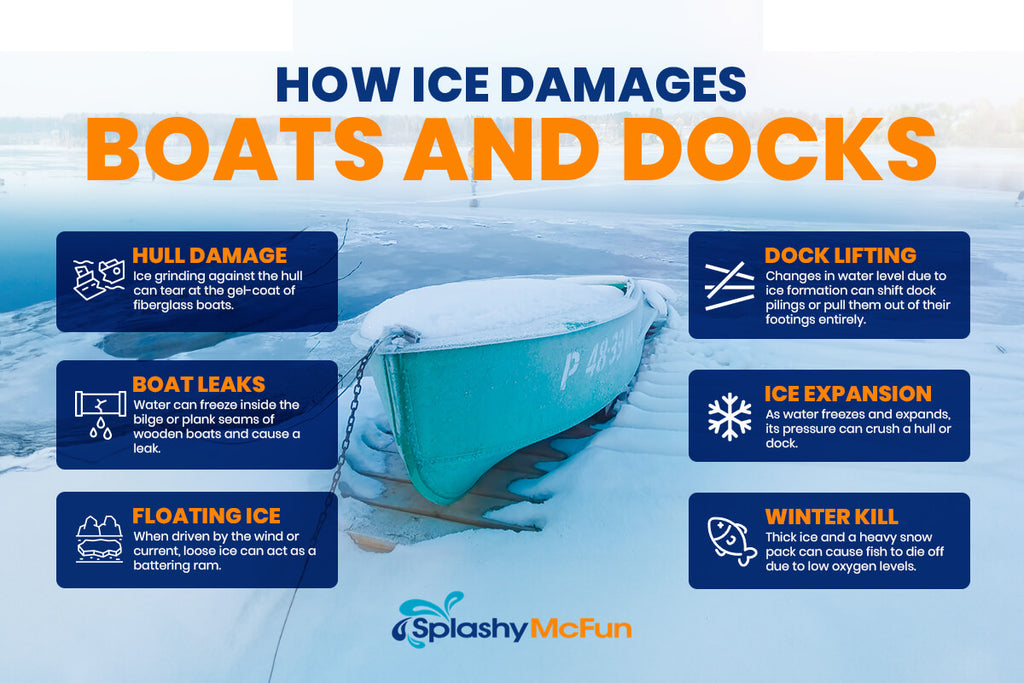Main Menu
Paddle Sports
Boating & Swimming
Inflatable Boats
Ice Eaters &. Fountains
How to Use Dock De-icers to Protect Boat Lifts and Docks
November 02, 2025 7 min read

How to Use Dock De-icers to Protect Boat Lifts and Docks
* Updated November 2, 2025 - Originally Posted Feb. 11, 2024
Lakeside property owners need to protect their boats and docks from ice damage during the winter months. Ice forming around them can lead to costly repairs and significant harm, making it a serious concern. Dock de-icers are the best solution to this problem.
This article covers everything you need to know about using dock de-icers. You will find out how to keep your boat, boat lifts, and docks safe from ice. This guide will show you how to pick the right dock de-icer, set it up, and keep it working well. You'll also see how it will help keep fish and plants healthy during winter. Read on to learn all about protecting your docks and boats from ice
Understanding Dock De-Icers: Your First Line of Defense
Dock de-icers are machines used to stop ice from forming or to melt ice that's already formed, especially around docks, boats, and marinas. They help keep these areas safe from damage caused by ice and make sure fish and plants in the water stay alive when it's cold.
How Dock De-Icers Work

Dock de-icers pull warmer water from the bottom to the top of the water. Warm water sits deeper, so bringing it up helps keep ice away. The ideal place for a de-icer is just below the surface, between 2.5 and 5 feet deep. In very shallow water, a de-icer might not be as effective.
Also, objects like boat lifts or large dock supports can block water flow, reducing the de-icer's effective area. In places with changing water levels, you can use a de-icer float to move with the water. If you have a dock on a lake where water levels change, a dock mount is another good option.
Dock de-icers are very important for keeping docks and the water around them safe in winter. They help avoid two big problems: ice jacking, where ice lifts and damages the docks, and ice expansion, where ice grows and applies a lot of pressure against the dock. By keeping the area around the dock free of ice, de-icers stop this kind of damage.
Guidelines for Effective Winter Protection
Winter can be tough on boat docks and the surrounding water. To keep everything safe, you need to use a de-icer. Here’s how to do it right:
1. Choosing the Right Dock De-Icer
Pick a dock de-icer that fits the weather conditions where you live. The recommended ice eater will vary depending on the size of the area that you need to keep free from ice. A single ice eater can maintain an 80ft diameter opening. You can use multiple ice eaters if a larger opening is needed.
2. Proper Installation
- Correct Positioning: You can mount your unit vertically to create a circular opening. If the area that you want to keep free of ice is longer and skinnier, you can mount it at an angle or even horizontally. Horizontal mounting is also going to be your best option in shallow water.
-
Mounts: Mounting your dock de-icer vertically with mooring ropes is the easiest and most common use. Some may prefer a dock mount, a floating mount, or a shallow water mount. Dock mounts connect directly to the dock and allow you to lock the de-icer into the desired position/angle to create your desired opening.
A floating mount can be used to horizontally mount the deicer to create an oval-shaped opening. Also, a good option in shallow water. Shallow water stands are another option to mount horizontally. These are most often used by waterfowl hunters to keep ponds open for the ducks and other fowl to land in.
3. Regular Monitoring and Maintenance
Check on your dock de-icer, especially in extreme temperatures. Look for any signs that it's wearing out or not creating the opening that is expected. When storing your ice eater, keep it in a dry area and store it upside down; propeller down. This keeps the seals lubricated and will save you from extra maintenance.
Keeping your de-icer on a regular maintenance schedule and getting it serviced every few years will keep it working better and make it last longer. This will save you trouble, headaches, and money down the road.
Best Practices
When winter comes, keeping your boat lifts and docks free from ice is important. Here’s how you can do that with some smart moves and the right de-icer setup.
A. Boat Lifts
-
Tailoring Dock De-Icer Placement
Every boat lift is unique, so you may need to experiment a bit, but we can give you some solid guidelines. You want the machine to easily be able to pull water up and disperse it. Any obstructions in the water can affect the flow of the warm water and how much area you are able to keep free from ice. Boat lifts can affect the water flow, but other unseen obstructions are what we need to look out for. Crappie beds or simply a sharp change in the depth of the water can alter the flow of the water. Most of the time, users will only have to make a minor, simple adjustment
- Electricity Requirements
Most dock de-icers are available in 115V or 230V. The amps will vary between units, but will pull between 2-9 amps depending on the size of the unit. For example, a 1/4 horsepower unit might pull around 2 amps, while a 1-horsepower unit can pull around 9 amps.
B. Dock Maintenance
-
Customizing Dock De-Icer Use
Just like with boat lifts, you need to adjust how you use dock de-icers for your dock. Think about how your dock sits in the water and where ice usually forms. You might place a de-icer at an angle to push warm water towards the dock, or you might need a couple of de-icers set up around the dock to make a safe zone free of ice.
-
Other Options than De-Icers
A dock de-icer is the most often used device for keeping water free from ice, but there is another option. Diffused air aeration units, or dock bubblers, can also be used to keep your dock protected. They use compressed air that flows through tubes and into settings on the floor of the lake. They use a steady flow of air bubbles to bring the warmer water from below up to the surface. In some areas of the US, these are the most popular. See the EasyPro Dock Bubbler for an example.
-
Watch for Ice/Snow on Dock Roofs
Ice and snow can build up on a dock's roof and cause serious damage. The weight can cause support beams to collapse and can even sink the dock. If your boat is in a slip when the roof collapses, it will most likely suffer severe damage. This can be a tough situation, as getting on an icy roof is not a good idea.
We have seen that happen at our home lake, Lake of the Ozarks, and it is no fun to deal with. Repairs can be expensive, and if many docks in your area are affected, dock companies are going to have more work than they can handle. This could lead to long wait times and you missing out on fun in the summer!

Safety Precautions
When it's cold and you're using de-icers to stop ice from forming around your boat docks and lifts, you need to be careful. Here's how to stay safe while keeping everything ice-free.
Follow the Instructions
With every dock de-icer, there is a manual or instructions for use. It is essential to obey these instructions because they show you how to use the de-icer correctly and efficiently. Some of these directions include how to assemble it, where to put it, and how to keep it in good condition. When you use the de-icer according to how the manufacturer designed it, you will avoid unexpected accidents.
Make Sure Electricity Requirements are Met
Make sure your outlets are working properly and that they can support the amps that are pulled at startup and while running. The last thing you want to do is spend money on the perfect de-icer to keep you free from damage and then have it stop working because of a tripped breaker.
Regular Inspection of Equipment
You have to monitor your de-icing equipment frequently so as to ensure it is in perfect condition. This implies searching for any signs of breakdown, like cracking or rust, and ensuring that all the parts are undamaged. If you find anything wrong with it, fix it or change it immediately.
This protects the devices from breaking down when you need them. You should give them an annual cleaning and inspection before storing them for the summer. Every 3 years or so, you should have them serviced by a professional. This will keep them operating at optimal levels.
If you have a vacation home where you use your dock de-icer, we also recommend using a wi-fi camera and/or outlets so that you can control them when you aren't there. Thermostats and timers are also available so that you don't run your ice eater when you don't need to.
Conclusion
Buying a good dock de-icer is wise for anyone who owns a boat or manages a marina. Knowing about different de-icers, how to install them, and how to keep them up helps keep your boats and docks safe from ice. Get ready for winter – some planning can help your marine gear stay safe and sound all season.
Ready to protect your docks and boats this winter? Check out our collection of dock de-icers to find the perfect fit for your needs. Keep your marine equipment safe and secure – browse our range today!
Please contact us with any questions. We are here to help!
You can download this article here: Download
Related Dock De-Icer Resources:
Splashy Spotlight: Bearon Aquatics - PowerHouse Ice Eater Review (Download) (Infographic) (Brochure)
The Best Dock De-icers for Boats, Docks, & Marinas (Download blog)
Bearon Aquatics Ice Eaters - Protect Your Boat this Winter (Download pdf)
How Dock DeIcers and Ice Eaters Protect Your Dock from Ice Damage (Download PDF)
What to Look For When Buying a Dock DeIcer or Ice Eater (Download PDF)
Preparing Your Dock for Winter With a Dock De-Icer (Download PDF)(Infographic)(Brochure)
Download our helpful Infographic by clicking here
Choosing a Dock and Boat Ladder: What Should You Be Looking For? (Download) (Brochure) (Infographic)
Important Reasons to Install Your Dock De-Icer Before Winter Arrives (Download) (Infographic) (Brochure)
Leave a comment
Comments will be approved before showing up.
Subscribe
Sign up to get the latest on sales, new releases and more …

